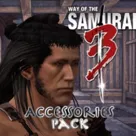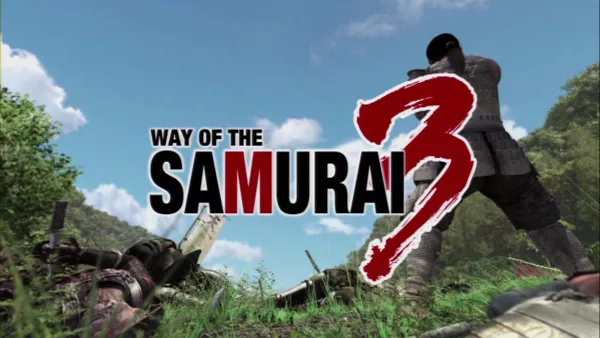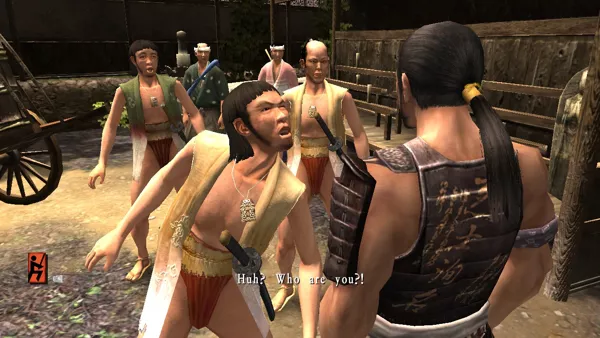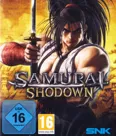Way of the Samurai 3
Description official description
Way of the Samurai 3 follows the same principles as its predecessors and is once again designed to offer an authentic settings, a deep sword-fighting system, and cause-and-effect role-playing. This time around the game takes place during the Sengoku Period and puts the players into the sandals of a lone samurai. As the only survivor of an epic battle, he enters the world of Amana which is currently ruled by Shuzen Fujimori who had overthrown the former superior Lord Sakurai. But the Fujimori Clan isn't very liked in the region so Shuzen has to rule the area with an iron fist in order to keep control.
The player is thrown into this struggle and has to decide if he wants to join Fujimori Clan, Ouka Clan (formed by former members of the Sakurai Clan), protect the villagers in Takatana who just want peace or just get out of Amana for good (which will lead to a complete reset of the game). The game offers the player almost complete freedom to roam the eight zones of Amana while looking over the shoulder of his avatar. The overall story arc allows for over 20 possible endings. Which one the player gets, depends on his actions and choices throughout the game - including if he always bumps into people, making them angry and attack the player. To that end, the length of the game greatly varies depending on what the player does. The shortest way e.g. would be to just go and kill both faction leaders which can theoretically be done in less than an hour thanks to the ability to often even act during cut-scenes and dialogues.
While they play out and even during normal gameplay, the player has three choices: listen, apologise/beg or attack. Begging a merchant will earn the player a free item but will also greatly reduce the respect the merchant has for the player which in the end may lead to less Samurai Points after death or completion of the game. The game is divided into different scenes with the next possible ones marked on the in-game map, making it easier for the player to follow the red ribbon.
The game features a realistic day and night cycle which has a great affect on the NPCs who live their ordinary lives even without the player interfering. The player can talk to various characters, accept different jobs (only one at a time) and shop for new items. In addition are also a few mini-games like chopping up vegetables or fillet fish. Decisions influence the relationships with the different groups changing the way they interact with the player and there are dozens of swords, hammers and spears to choose with which he can defend himself. He has to to keep the variable quality and durability level in mind though. With these weapons, the player can perform both offensive and defensive moves depending on his fighting style, and even special actions. There are several dozen moves available for unlock which will even stay available for each new game. More importantly the player can decide if he wants to kill an person or fight with a blunt weapon. While killing can be bad for the reputation, throwing down an enemy only with a blunt attack will result in another meeting further down the road for sure. If the right weapon isn't dropped by an enemy, the player can go to the blacksmith and forge a new one out of spare parts or enhance and upgrade an existing one, according to his fighting style and in exchange for money.
During the course of the game, the player will also meet several possible partners. While some will join him in exchange for money, other can be "romanced". In any case the person will then follow the player around, giving him an additional edge in combat and also unlocking access to mini-games and side jobs which can only be done with two people. The romance with the partner can even go as far as the partner deciding to live with him in his home in Takatane village. There the player can sleep till a certain hour in order to restore his health and has access to a weapons safe as well as a closet where he can story his stuff as he can only carry three weapons at a time and no additional clothing.
Spellings
- 侍道3 - Japanese spelling
Groups +
Screenshots
Promos
Videos
Add Trailer or Gameplay Video +1 point
See any errors or missing info for this game?
You can submit a correction, contribute trivia, add to a game group, add a related site or alternate title.
Credits (PlayStation 3 version)
284 People (235 developers, 49 thanks) · View all
| Director | |
| Creators | |
| Project Managers | |
| Producer | |
| Lead Programmer | |
| Programmers | |
| Technical Director | |
| Technical Support |
|
| [ full credits ] | |
Reviews
Critics
Average score: 59% (based on 20 ratings)
Players
Average score: 3.4 out of 5 (based on 14 ratings with 2 reviews)
The Good
Way of the Samurai 3 will begin by making a character with it's own name and personal outfit. You start out as a nearly unconscious samurai picked up by the villagers from the battlefield in Amana. During the game, you can interact with villagers and be presented with various options in which your player can freely respond, I have always liked this feature in the series.
Your player can take jobs from three factions, the villagers, the Sakurai clan or the Ouka clan with each having different missions and eventually a different ending. The missions were not to hard, but they get repetitive sometime. There are also several mini games like chopping food with your sword or making rice, which is a nice addition.
When moving on to the gameplay, Way of The Samurai 3 had worked out just as I expected from the previous series. You draw your sword by pressing the L1 button or defend during an attack with the R1. You can also choose to defeat an enemy by using a blunt attack, but remember when you attack or kill people in Way of the Samurai 3 will let you lose respect and affect the overall score you get when you finish the game.
The Bad
The only thing that I did not like were the animation of the characters. The majority of the graphics in this have a PS2 look, and I encountered a slower gameplay when fighting multiple enemies. I think that whole game would look a lot better if the developers would spend more time on making the characters more detailed than the environments. I have also spotted a few glitches and bugs here and there, but they were not to distracting.
The Bottom Line
Way of the Samurai 3 is the third game in the series, and I personally liked this one the most. As in the previous games, you will take the role of an samurai in Japan trying to make a name for himself. Personally, I found it a very enjoyable and addicting free roam game. If you don't mind the graphics, you have one of the better samurai games that are on the market today. I definitely recommend it for fans of samurai games.
PlayStation 3 · by Deleted (374) · 2011
This game squandered potential and is a regression in the series.
The Good
Way of the Samurai 2 showed an understanding of improvement from the developer. I guess they just slacked off for 5 years between instalments, because this one is a huge let-down.
Let's get to work:
LET'S TALK GAME-PLAY
- It's a compromise between the first and second games for moving around and exploring. The first was very limited, a lot like the story mode in Bushido-Blade, where you'd run around to different areas with a load screen in-between. The second was very structured, with a menu screen and set time phases. This one allows you to do both, but removes the 'set days' limit to allow for more resource gathering.
- The combat is the same as 2, but the addition of an ability to flip your weapon (blunt side for swords, butt end for spears) to do blunt damage and spare opponents is one of the few props I'll give this game.
- Spears spice things up a little, although they suffer from less imaginative moves than the swords.
- You now have the option of apologizing or drawing your weapon during cut-scenes, to various effects.
- You are not forced to save after you get killed - you can regress to a prior save. This is actually a big deal because if you die just before the conclusion there's no way you want to start over.
LET’S TALK GRAPHICS:
- The opening cut scene is beautiful, visceral, and I refuse to believe those same people worked on the in game models.
- HDR really gives a texture to day and night that is stunning.
- Depth of field instancing is nice.
LET'S TALK SOUND
- There is more authentic and less synthesized sounding music here.
- More focus on group scenes with background talking, which is more realistic.
LET'S TALK STORY:
- The first game was in the Meiji era. The second in the Edo era at the beginning of the Tokugawa Shogunate. This one is set in the late 16th century - a time of total war as Nobunaga Oda and then Daimyo Tokugawa Ieyasu led vast armies and set the stage for the Sengoku period. By the end of the period heavy armour and spears would lose prominence and birth the the Edo period, the beginning of the end for the Samurai class. This is an interesting time period and a logical choice as the series progresses back into time.
- In prior games the side of the peasants has been illustrated through warriors wanting to fight for them. This time it is through an older man who gave up his sword for a hoe and became a farmer. I like that sentiment - that realism. He's seen both sides and wants the main character to give up his sword and learn how to make life grow instead of cut it down.
The Bad
LET'S TALK GAME-PLAY
- It takes about 10 minutes usually to get a good sense of what a game is like. Sometimes initial impressions are wrong (see Jagged Alliance), sometimes you can tell right off that it's not going to be a fun time (see Alone in the Dark). I paid $25 for this (this year). It's worth maybe $15.
- It's copied and pasted from 2, I sincerely doubt a lot of new work was done on this. This isn't a hockey game guys, you can't get away with that!
- In the first game, when you talked to people, they'd make an annoying "Ohio" sound, or a whining "Eyeh" sound. It was badly recorded and annoying. And they'd make it with every text box that popped up. We're talking every 3 words or so. It made talking to people something annoying. The second game, the annoying sounds were better recorded. Now, again, it's 5 years later. And it's the same thing.
- The game hasn't crashed, but the slow down kicks in more than it should.
- 'Way of the Samurai' hasn't been able to address certain things before this game. Did you know that a large part of Japanese culture in this era revolved around a Shinto concept of 'Cleanliness'? That looting bodies was seen as an unclean behavior? Well the game does, and it addresses it, but it doesn't punish you for doing it. Not for stealing either. It kind of breaks this 'simulation' a little when I can just steal crops from starving people and not be fined for it. If you're going to bring it up, use it. Basic competence fail right there. Punch a peasant lose 50 points, steal from him, eh, who cares?
LET’S TALK GRAPHICS:
- Go watch the opening movie on youtube. I'll wait. Pretty good, right? Well I'm sure they outsourced that, because these are some lazy people at work here. I can't understand how people who take such care to choreograph elegant fight moves fail on a something so basic as facial expressions and movement. Cut-scenes are painful to watch. They're ugly, unrealistic, and people sit stock still inflating and deflating like balloons, starting forward with dead eyes.
- FACES, DON'T, WORK THAT WAY. The mouth doesn't just explode open and shut... This is just stupid. This is four years after MGS: Snake Eater.
- No direction in scenes. They're horrible. You have to stare at your character standing perfectly still with no facial expression for about 5-7 seconds. Who thought this was acceptable?
- Serious lack of character models in this game. Even named characters and job givers are just generic models.
LET'S TALK SOUND
- I know ADR rates are kinda high, but seriously, it's 2008 and your characters just spit out syllables to indicate mood?
- The English dub sucks. It's not Resident Evil 1 bad, but I switched it over to the Japanese dub. I don't know if it sucks because my Japanese isn't anything to brag about.
LET'S TALK STORY:
- The story in this series has always been the point. Both previous stories have been pretty good. This one is up to snuff, but not spectacular.
- The characters in the previous games were part of the fun factor. Here they are seriously lacking, stereotypical anime characters. In the second game the Auto (ph) gang had a creepy goth chick(?), a noble if misguided leader, a smokin' blonde Courtesan, and a slimy Chinese agent to deal with. There were ninja hiding in the shadows, a seriously noble Samurai lord, his gay underling, and his fanatical strong-man.
- The set-up is too simple. The decent characters are too predictable. Some decisions (like having two Dojima blacksmith's) are just dumb. The map is confusing, confused, and although pretty. The leader of the Ouaka (ph) gang is built like Meng-Huo from Dynasty Warriors. Why?
**The Bottom Line**
Look, I bought this game because I liked the other two. I'm playing it right now and I'll keep playing it, but I have to be honest with you in that I was let down. They've lost my 'buying' trust, and I'll have to demo WOTS:4 before I purchase it. This game is an exercise in frustration. If you're wondering why I haven't brought up the 'weapon crafting' aspect of the game it's because I doubt anyone will want to play it long enough to earn enough skills to make a decent weapon. It's not a bad idea, but it's effort that should have been spent on the story or the engine - it's just something to put on the back of the box. Same with the companion system. Rent it first unless you can pick it up for what it's worth. $15.
PlayStation 3 · by Kyle Levesque (904) · 2012
Trivia
In 'A Tribute to Acquire', an article in Retro Gamer 240, 24 November 2022, Acquire's Takuma Endo reminiscences the game: "We had some budgetary constraints and weren’t able to arrange the budget we would have liked for the character models."
Analytics
Identifiers +
Contribute
Are you familiar with this game? Help document and preserve this entry in video game history! If your contribution is approved, you will earn points and be credited as a contributor.
Contributors to this Entry
Game added by Sicarius.
Windows added by Cavalary. PlayStation Now added by Sciere.
Additional contributors: Tim Janssen, aquapendulum.
Game added July 2, 2010. Last modified December 30, 2024.






















